The Reverse Creaming Method for Cakes
Introducing Reverse Creaming also know as Two Stage Creaming.
This is the first in a series of 7 “Cake Batter” classes. Over the course of the series we’ll test how changes to cake batter mixing technique and ingredients can alter a cake’s taste and texture.
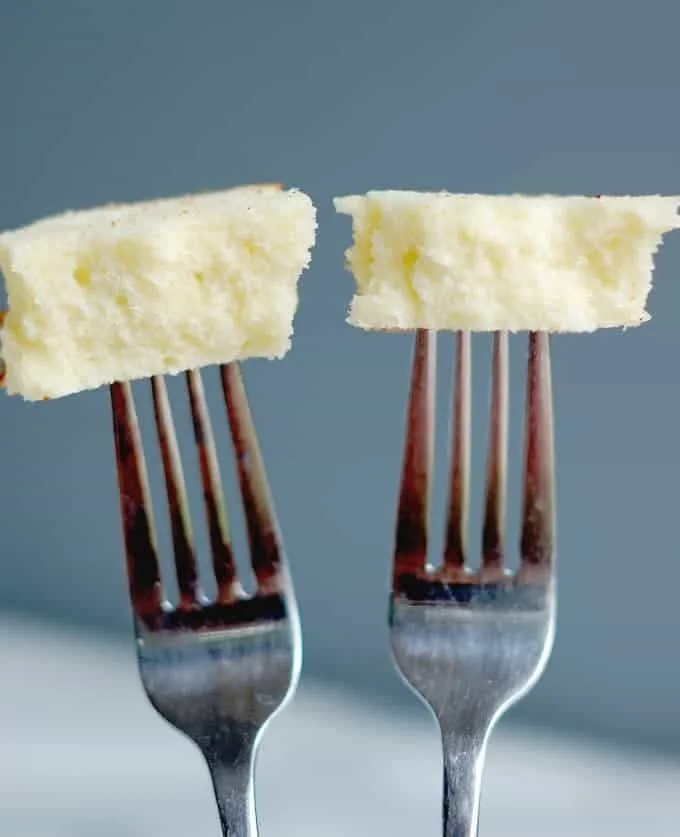
We’ll work with the original pound cake as our test recipe for the “Cake Batter” classes. Pound cake is a great tool for our purposes precisely because it’s a simple recipe with just 4 ingredients.
Pound cake got it’s name based on the original formula of 1 pound each of butter, sugar, eggs and flour. It’s called “quatre-quarts” (four-fourths) by the French.
For our science of cake batter series we’ll look at the role each ingredient plays in the batter. But first we’ll look at two cake batter mixing methods.
Traditional Creaming vs. Reverse Creaming
When I was in culinary school, our first lesson in the “cakes” section was the basic pound cake. Not only did we have to use the original “quatre quarts” recipe, we were required to cream the butter and sugar with a wooden spoon, by hand.
At the time it seemed a little ridiculous. We knew we’d never actually mix a pound cake by hand, especially in a pro kitchen.
But the exercise did reinforce how important technique is, not only for pound cake but for all baking.
What is the creaming method?
The traditional creaming method starts by beating together the butter and sugar. The sharp edges of the sugar crystals cut through the butter to create lots of little air bubbles. The eggs are added one at a time and the flour is added last.
As soon as the flour is added gluten, the protein in the flour that gives baked goods their structure, will start to form. As the cake bakes the air bubbles trapped in the butter will expand in the heat of the oven producing, in theory, a light and airy cake.
What is Reverse Creaming?
Reverse creaming, aka two-stage creaming, is an alternate technique used by many bakers (including me). Reverse creaming starts by beating together the flour, sugar and butter.
Gluten won’t start to form until the flour comes in contact with water (in the egg whites). Coating the flour molecules with butterfat before the eggs are added creates a barrier which slows the formation of gluten. Reverse creaming should, in theory, make a cake with a more tender and velvety texture.
Cake test – creaming versus reverse creaming
One way to compare mixing techniques is to run side-by-side tests. For each test I mixed one batch using the traditional creaming method and one batch using the reverse creaming method.
Each batch of cake contained exactly 8 ounces each of cake flour, granulated sugar, unsalted butter and eggs. The butter and eggs were at ideal room temperature, between 65-70°F.

- All ingredients were at ideal room temperature, about 65°-70°F.
- All cakes were baked in identical 9”x 5” loaf pans at 325°F in a convection oven.
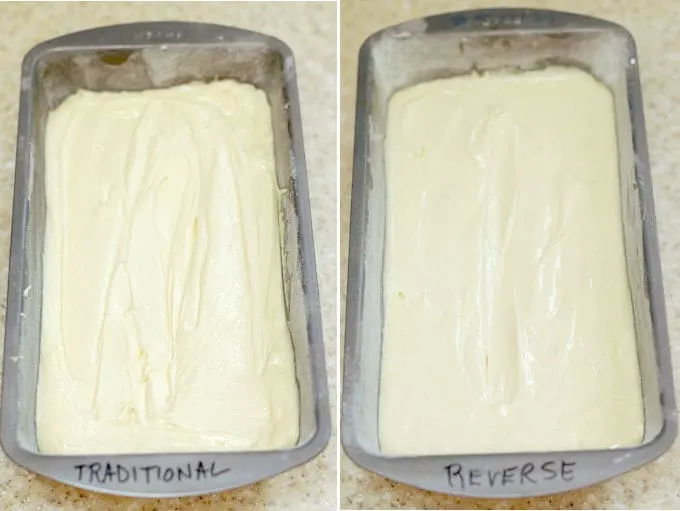
- The cake batters look similar going into the oven.
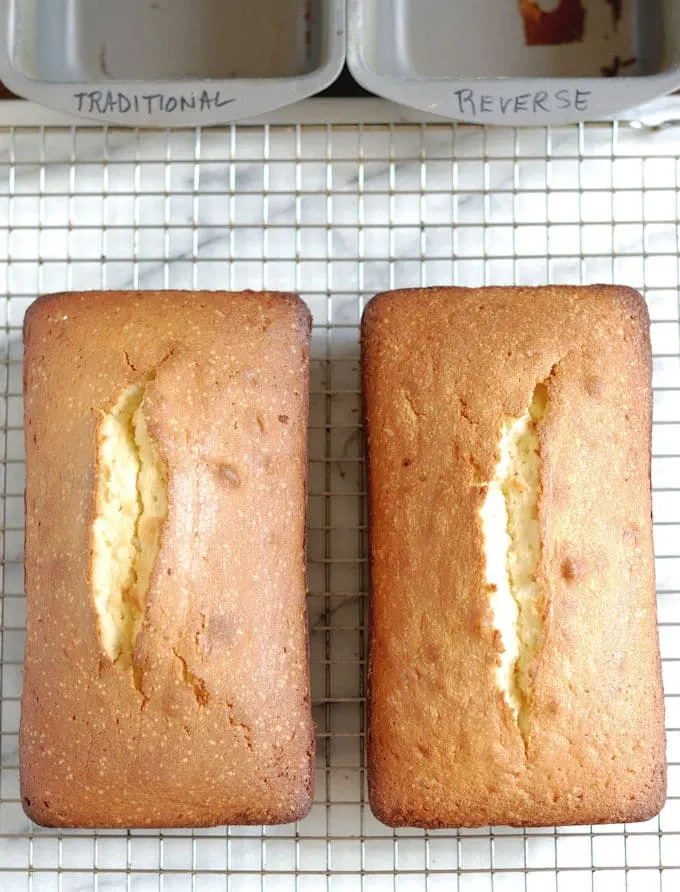
- The crusts on the cakes had slightly different texture.
Creaming vs. Reverse Creaming test results
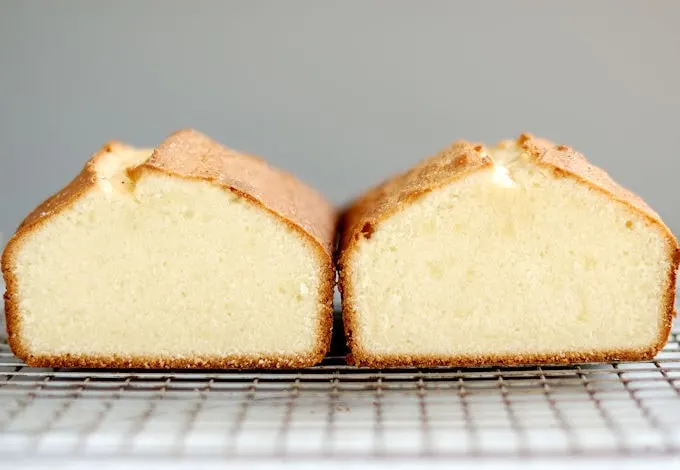
- At first glance, the cakes made with the different mixing methods looked very similar, but once I cut and tasted the cakes the differences became apparent.
- The cake made with the traditional creaming method had a very tight crumb and contained a few pockets of air. The cake was a little chewy with a slightly bouncy texture. I pinched a piece of the cake between my fingers and it held together a moment before breaking up.
- The cake made with the reverse method also had a tight crumb, but it was very consistent with no air pockets. The texture was softer and more tender. When I pinched a piece of that cake between my fingers it broke apart more easily.
Which is better, creaming or reverse creaming?
In tests using the exact same ingredients, a cake made with the reverse creaming method was softer and more tender. Which is why reverse creaming is my preferred mixing method.
Other cake batter classes:
Next up: Cake Batter Class #2 will explore how adding salt, flavorings and leavening can improve on the basic pound cake recipe.
- The function of flour in cake batter
- The function of eggs in cake batter
- The function of sugar in cake batter
- The function of fat in cake batter
- The Cake recipe formula
When we’re done experimenting with all the ingredients for this “cake batter” course, we’ll use all we’ve learned to create Pound Cake Perfection.

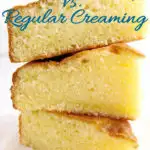
Hi totally in love with all your posts. I have one small question. Why is that the cake made with creaming method has air pockets and not in the reverse method ?
Thank you
Are you referring to how the cakes look in the photos? Regular creaming method does incorporate more air into the batter, but I find the reverse creaming creates a more consistent and smaller crumb, which I prefer for a pound cake.
Hi Eileen!
I have been searching for the perfect cake recipe and decided to do some research and studies about it. It was when I found your blog.
I never heard of reverse creaming before and I am very curious about it, and will give it a try one day. But I was thinking, does the reverse creaming will work in any cake recipe? When is the case to use reverse creaming to improve the outcome of a cake?
There’s still so much to tell and also, but I will leave to it for now. Thank you!
I can’t say 100% since I haven’t tried every recipe. But, in my opinion, the reverse creaming method could work for any recipe that is written for the “creaming” method.
Thank you Eileen!
It has been frustrating to bake. I moved out my country and the recipes that I used there and it worked perfectly, are not working here. I know everything can influence – type of flour, butter, oven, pan etc. I have been trying to figure out what’s wrong and how to change, but unfortunately I can’t test all the time – where all the cakes will go?
The last one I tried I was super happy with the batter – it looked the same way as back home, and it came out of the oven beautifully – fluffy and light to the touch, risen even. But it got dense once it cooled down. Didn’t try the reverse creaming yet, but as soon as I do, I will let you know. Thank you!
Hi Eileen,
I stumbled upon your website and am so glad that I did. I love your recipe and your have very clearly explained the science behind baking. I have tried several recipes for a soft and moist cake but never managed to get the texture what i was looking for. Yesterday i made your Vanilla Butter cake with the reverse creaming with whipped egg whites method. OMG!!!
I can’t thank you enough for this method. The cake turned out so soft. I have never had any of my cakes turn out so soft. I am definitely using this method for all the other cakes,
But I am stuck for people who cannot eat eggs. I have a lot of people around me who do not have eggs and if i need the same texture for the cake, what can i replace the eggs with?
Will i still get the same results???
Would appreciate your reply on this.
Thank you so much.
Hi Jeny, Eggs are a tough one with baking. I’ve used Bob’s Red Mill egg replacer with good results when making cookies. I haven’t tried it with this recipe, but I think it’s worth a shot. You won’t be able to make whipped whites with the egg replacer.
Hi Eileen,
Thank you so much for your reply. But here in India where I stay i haven’t seen an egg replacer anywhere in the market. Hence am in a dilemma. any other suggestions for replacing eggs?
Sorry for asking too many questions. Have just discovered my love for baking and want to be able to make whatever people around me demand.
Thanks again.
Hi Jeny, sorry I don’t have a good answer for you. I know some people use the water from canned chickpeas (aquafaba) to replace egg whites. You can experiment with that. Here’s a website with some ideas for replacing eggs.
Thank you so Much Eileen. I will check out the website.
Meanwhile i made your white cake. It turned out awesome. But my only issie is the cakes settle quite a bit after they come out. I did what you mentioned about lining just the bottom of the pan and no flour on the sides. But the cake settled down. Any solution on that?
Please forgive the length of this question. :).
I have a bundt cake recipe that I make and love. The first time I made it, I followed the instructions exactly, which are basically dump sugar, butter and all wet ingredients together – mix – then add all dry ingredients and mix again. The second time I made the recipe, I forgot that it called for that and I basically used the regular creaming method that recipes typically use. That time, my bundt cake fell. When I remade the cake following the dump and mix method, it was once again perfect. This is bending my mind into a pretzel. I am an avid baker for many years, but only just now learning about the science behind baking.
Do you have any idea why this would have happened?
Also, when a cake calls for the the regular creaming method, can you always use the reverse creaming method if you prefer (as i do), or are the circumstances where you should not use it?
I love your blog and appreciate the baking science series very much!
Thank you! ‘
First, I’d like to invite you to join my private Facebook Group called Baking Sense Recipe Workshop . Anyone can join if they ask. I set up that group specifically to answer questions like this. The group is made up of bakers who like to help other bakers. It is a little hard to answer this question specifically without seeing the recipe. A first guess might be that by creaming the butter and sugar you introduced more air into the batter than normal and the batter couldn’t hold the air and the cake fell. Generally, any cake that can be successfully made using the creaming method can be made with the reverse creaming method.
Hello! I just discovered reverse creaming and I love it! I’ve used it for my white cake recipe religiously. But my question is regarding eggs. I’ve typically whipped egg whites (for the white cake recipe) before adding to the bowl. Do you whip your eggs (in any recipe)? Or do you add them in directly? Thank you in advance.
Hi Dena, I whip the egg whites for my Vanilla Butter Cake Recipe. The cake is a little lighter than a pound cake. If you visit the Eggs in Cake Batter post you can read how whipping the whites not only lightens but also tenderizes the cake. If you’re interested in questions like these I definitely recommend reading through the entire Cake Batter series. I also have a private Facebook Group (anyone can join if you ask) that’s all about bakers talking about recipes and helping each other fix recipe issues.